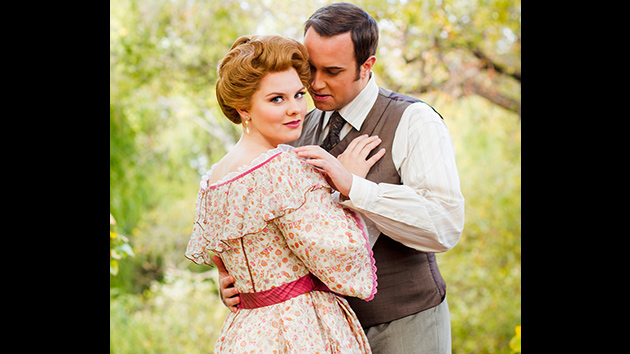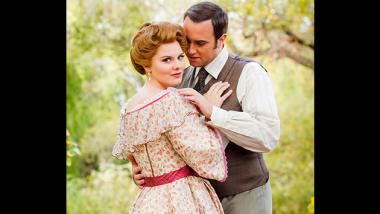
It may be the title of Opera San José’s fast approaching, professional world premiere, but Where Angels Fear to Tread also aptly describes the caution with which many opera companies approach new work. A company can’t mount the warhorses in heavy rotation, year after year, and remain vital and relevant; still opera executives and boards worry about half-empty houses for something out of the ordinary.
In the case of composer Mark Lanz Weiser and librettist Roger Brunyate’s exciting adaptation of E.M. Forster’s Where Angels Fear to Tread, such worries seem unjustified. As YouTube excerpts from the 1999 student premiere of the opera (at the Peabody Conservatory of John Hopkins University in Baltimore) show, the score’s gripping, romantic music brings Forster’s enthralling drama to life, and has the potential to hold you at the edge of your seat.
That’s certainly how Angels struck the late mezzo-soprano Irene Dalis, who founded Opera San José in 1984 and served as general director until her retirement last year. When Bryan Nies, who had conducted several operas for the company and was also serving as assistant conductor at the Peabody Opera workshop, first brought the work to her attention, it sat around for several years until Lanz Weiser sent along a DVD of the Baltimore production.
After taking it home for the weekend, Dalis returned to work on Monday with her mind made up.
“Irene was very interested in Angels,” said Dalis’ longtime cohort and successor as general director, Larry Hancock. “She knew I was writing the company’s three-year plan, and she wanted me to know this opera before I made up my mind, because producing it might change the kinds of artists she was engaging. So she called me into her office and said, ‘Larry, I want you to listen to this opera.’
“I said, ‘Okay, I’ll listen to it this weekend.’ And she said, ‘No, I want you to do it now.’
“I replied, ‘Irene, it’s 11:30 in the morning on Monday. The three-act opera is probably three-hours long. Monday morning does not seem the best time.’ But she said she wanted me to watch it now!”
Hancock looked through the score, and remembered that he had found the story genuinely interesting when he had read it, many years before, in college. Then he dove in.
“I put on the Opera Workshop performance,” he says. “Ultimately, it kicked me in the gut. It was riveting, powerful, and painful to watch, and then had a nice, calming resolution at the end.”
“Ultimately, it kicked me in the gut. It was riveting, powerful, and painful to watch, and then had a nice, calming resolution at the end.” – OSJ Artistic Director Larry Hancock
When he returned to Dalis’ office, score in hand, she took one look at him and said, “Ah, you watched it all the way through, didn’t you? And you’re going to produce it, aren’t you? And you’re going to do it in your first season, aren’t you?”
Hancock, who was accustomed to the authority with which “Miss Dalis” spoke, replied that he would not fear to mount Angels in his first season if he could engage Lillian Groag to direct. He initially wanted to open the season with it, but Groag was neither available nor certain that she wanted to return to OSJ after an 18-year hiatus.
Groag, a stage director and notable playwright whose upcoming directing assignments include productions for Opera Omaha, Teatro Stabile di Bolzano in Italy, American Conservatory Theater, Louisville Opera, and a festival of plays in New York City, was not so set in her ways. Once she watched the DVD, she returned Hancock’s call.
“Larry, I have to direct this opera,” she declared. “Let me see how I can adjust my calendar.” In a week, she had cleared midwinter, which allows Hancock to present the premiere February 7-22, in his first season as General Director.
Lanz Weiser, who as an undergraduate had already written a half-hour opera, was still a student when Roger Brunyate, artistic director of the Peabody Opera Theatre, agreed to collaborate as librettist on a full-length opera. Brunyate, who had already written numerous libretti, had also served as a producer at the Glyndebourne Festival and artistic director of the Wolf Trap Opera Company and young artists program, among many other credits. He's a man with opera in his blood.
One of the stories Lanz Weiser was drawn to was E.M. Forster’s Room with a View. Brunyate, who had known Forster at Cambridge, instead suggested he take a look at Where Angels Fear to Tread because he believed it was more overtly dramatic.
“One of the things I really love about the tone of Angels is that, for three-quarters of it, it’s a comedy,” says Lanz Weiser. “I really wanted to do comedy because it was outside of my comfort zone. I was one of the rehearsal pianists for Mozart’s The Marriage of Figaro, and I love the comedic nature of that opera. That opera can also be dramatic, and Angels has this significant, crazy, dramatic turn at the end that also really appealed to me.
“The opera bug first hit me when I saw Mozart’s Don Giovanni at Peabody and was blown away by it. I love the drama, and I love the sound of operatically trained singers. I am a fan of opera, and hope my love for its music and drama really comes through.”
“I love the sound of operatically trained singers. I am a fan of opera, and hope my love for its music and drama really comes through.” – Composer Mark Lanz WeiserHancock and his creative team have cut a few lines for dramatic purposes, with Lanz Weiser’s approval, and changed a few words, but the only major alteration was to the character Gino’s physical appearance.
“The book describes Gino as a slight man who looks older than his 21 years. But we went for Gino as a big man, because I think that helps the drama. Gino has to be very frightening at one point, frightening enough to kill the tenor with his hands. If he was a little guy, there was not going to be any fear factor. So we engaged big, muscular, athletic Matthew Hanscom to play Gino. He threatens physical violence twice in the opera, and both times, you feel, oh boy, if he loses control, something bad is going to happen.”
Hancock’s decision to typecast stems from his basic feeling about how to present sung drama onstage.
“Irene was always keen on acting, and I am too,” he declares. “She wasn’t so keen on physical body type, but I am. I think it’s a shortcut for the audience. I have great sympathy for the audience. If you’re supposed to being playing a 14-year old, I would like you to be small and slender; if you’re supposed to be playing a 50-year old, I’d like you to be tall and a little more rotund. I would like the audience to see you and know and not have to wonder. It’s bad enough that you have to send out a woman to play Cherubino. At least she’s in knickers.”
“Irene was always keen on acting, and I am too. She wasn’t so keen on physical body type, but I am.” – Larry HancockHancock is as convinced by Lanz Weiser’s music as he is thrilled by Brunyate’s libretto.
“Roger approached Forster’s work with great sensitivity,” he declares. “And he also has a great sense of drama. I always thought Auden’s libretto for Stravinsky’s The Rake’s Progress was the most beautiful libretto in English. But there are moments in Brunyate’s libretto that are easily as beautiful as anything in Auden. It’s really quite startlingly beautiful.
“Gino is just so honest and vulnerable. Here he is, this strong man. But he has this tiny, little 8-month old baby, and he says, ‘I am a man alone. I am not enough for this child. I need a wife.’ It’s so moving it makes you cry.”

